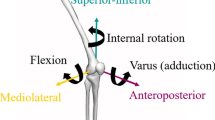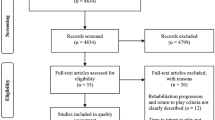Abstract
Computational modelling is an invaluable tool for investigating features of human locomotion and motor control which cannot be measured except through invasive techniques. Recent research has focussed on creating personalised musculoskeletal models using population-based morphing or directly from medical imaging. Although progress has been made, robust definition of two critical model parameters remains challenging: (1) complete tibiofemoral (TF) and patellofemoral (PF) joint motions, and (2) muscle tendon unit (MTU) pathways and kinematics (i.e. lengths and moment arms). The aim of this study was to develop an automated framework, using population-based morphing approaches to create personalised musculoskeletal models, consisting of personalised bone geometries, TF and PF joint mechanisms, and MTU pathways and kinematics. Informed from medical imaging, personalised rigid body TF and PF joint mechanisms were created. Using atlas- and optimisation-based methods, personalised MTU pathways and kinematics were created with the aim of preventing MTU penetration into bones and achieving smooth MTU kinematics that follow patterns from existing literature. This framework was integrated into the Musculoskeletal Atlas Project Client software package to create and optimise models for 6 participants with incrementally increasing levels of personalisation with the aim of improving MTU kinematics and pathways. Three comparisons were made: (1) non-optimised (Model 1) and optimised models (Model 3) with generic joint mechanisms; (2) non-optimised (Model 2) and optimised models (Model 4) with personalised joint mechanisms; and (3) both optimised models (Model 3 and 4). Following optimisation, improvements were consistently shown in pattern similarity to cadaveric data in comparison (1) and (2). For comparison (3), a number of comparisons showed no significant difference between the two compared models. Importantly, optimisation did not produce statistically significantly worse results in any case.





Similar content being viewed by others
Availability of data materials
The pre-existing MAP-Client is freely available here: https://map-client.readthedocs.io/en/latest/with additional information provided here https://simtk.org/projects/map. Note the framework is currently only available in Python 2, an updated version for Python 3 is currently being produced by the original developers. Updates regarding the status of this update will be provided on the above SimTK link. The developed frame generated as part of this research is available upon reasonable request from the corresponding author. The models generated as part of this research are available upon reasonable request.
References
Ackland DC, Roshan-Zamir S, Richardson M, Pandy MG (2011) Muscle and joint-contact loading at the glenohumeral joint after reverse total shoulder arthroplasty. J Orthop Res 29:1850–1858
Andersen MS (2018) How sensitive are predicted muscle and knee contact forces to normalization factors and polynomial order in the muscle recruitment criterion formulation? Int Biomech 5:88–103
Arnold EM, Ward SR, Lieber RL, Delp SL (2010) A model of the lower limb of analysis of human movement. Ann Biomed Eng 38:269–279
Bahl JS, Zhang J, Killen BA et al (2019) Statistical shape modelling versus linear scaling: effects on predictions of hip joint centre location and muscle moment arms in people with hip osteoarthritis. J Biomech 85:164–172
Bakke D, Besier T (2020) Shape model constrained scaling improves repeatability of gait data. J Biomech 107:109838. https://doi.org/10.1016/j.jbiomech.2020.109838
Barzan M, Carty CP et al (2019) Development and validation of subject-specific pediatric multibody knee kinematic models with ligamentous constraints. J Biomech 93:194–203. https://doi.org/10.1016/j.jbiomech.2019.07.001
Brito da Luz S, Modenese L, Sancisi N et al (2017) Feasibility of using MRIs to create subject-specific parallel-mechanism joint models. J Biomech 53:45–55
Buford WL, Marty Ivey Jr F, Malone D et al (1997) Muscle balanace at the knee - moment arm for the normal and the ACL-minus knee. IEEE Trans Biomed Eng 5:367–379
Catelli DS, Wesseling M, Jonkers I, Lamontagne M (2019) A musculoskeletal model customized for squatting task. Comput Methods Bioemech Biomed Eng 22:21–24
Cleather DJ, Bull AM (2011) An optimization-based simultaneous approach to the determination of muscular, ligamentous, and joint contact forces provides insight into musculoligamentous interaction. Ann Biomed Eng 39:1925–1934
Davico G, Pizzolato C, Killen BA et al (2020a) Best methods and data to reconstruct paediatric lower limb bones for musculoskeletal modelling. Biomech Model Mechanobiol 19:1225–1238. https://doi.org/10.1007/s10237-019-01245-y
Davico G, Pizzolato C, Lloyd DG et al (2020b) Increasing level of neuromusculoskeletal model personalisation to investigate joint contact forces in cerebral palsy: a twin case study. Clin Biomech 72:141–149. https://doi.org/10.1016/j.clinbiomech.2019.12.011
Delp SL, Anderson FC, Arnold AS et al (2007) OpenSim: open-source software to create and analyze dynamic simulations of movement. IEEE Trans Biomed Eng 54:1940–1950
Demers MS, Pal S, Delp SL (2014) Changes in tibiofemoral forces due to variations in muscle activity during walking. J Orthop Res 32:769–776. https://doi.org/10.1002/jor.22601
Draganich LF, Andriacchi TP, Andersson GB (1987) Interaction between intrinsic knee mechanics and the knee extensor mechanism. J Orthop Res 5:539–547
Dzialo CM, Pedersen PH, Simonsen CW et al (2018) Development and validation of a subject-specific moving-axis tibiofemoral joint model using MRI and EOS imaging during a quasi-static lunge. J Biomech 72:71–80
Fick AE (1879) Uber Zweigelenkige Muskeln. Arch Anat Physiol (Anat Abt) 201–239
Garner BA, Pandy MG (2000) The obstacle set method for representing muscle paths in musculoskeletal models. Comput Methods Bioemech Biomed Eng 3:1–30
Gerus P, Sartori M, Besier TF et al (2013) Subject-specific knee joint geometry improves predictions of medial tibiofemoral contact forces. J Biomech 9:2–9. https://doi.org/10.1016/j.jbiomech.2013.09.005i
Guess TM, Stylianou AP, Kia M (2014) Concurrent prediction of muscle and tibiofemoral contact forces during treadmill gait. J Biomech Eng 136:21032
Hammer M, Gunther M, Haeufle DFB, Schmitt S (2019) Tailoring anatomical muscle paths: a sheath-like solution for muscle routing in musculoskeletal computer models. Math Biosci 311:68–81
Kainz H, Carty CP, Maine S et al (2017) Effects of hip joint centre mislocation on gait kinematics of children with cerebral palsy calculated using patient-specific direct and inverse kinematic models. Gait Posture 57:154–160. https://doi.org/10.1016/j.gaitpost.2017.06.002
Konrath JM, Saxby DJ, Killen BA et al (2017) Muscle contributions to medial tibiofemoral compartment contact loading following ACL reconstruction using semitendinosus and gracilis tendon grafts. PLoS ONE. https://doi.org/10.1371/journal.pone.0176016
Lai AKM, Arnold AS, Wakeling JM (2017) Why are antagonist muscles co-activated in my simulation? A musculoskeletal model for analysing human locomotor tasks. Ann Biomed Eng 45:2762–2774. https://doi.org/10.1007/s10439-017-1920-7
Lerner ZF, Demers MS, Delp SL, Browning RC (2015) How tibiofemoral alignment and contact locations affect predictions of medial and lateral tibiofemoral contact forces. J Biomech 48:644–650
Modenese L, Kohout J (2020) Automated generation of three-dimensional complex muscle geometries for use in personalised musculoskeletal models. Ann Biomed Eng 48:1793–1804. https://doi.org/10.1007/s10439-020-02490-4
Modenese L, Renault J-B (2020) Automatic generation of personalised models of the lower limb from three-dimensional bone geometries: a validation study. bioRxiv. https://doi.org/10.1101/2020.06.23.162727
Modenese L, Montefiori E, Wang A et al (2018) Investigation of the dependence of joint contact forces on musculotendon parameters using a codified workflow for image-based modelling. J Biomech 73:108–118. https://doi.org/10.1016/j.jbiomech.2018.03.039
Nardini F, Belvedere C, Sancisi N et al (2020) An anatomical-based subject-specific model of in vivo knee joint 3D kinematics from medical imaging. Appl Sci 10:2100
Navacchia A, Kefala V, Shelburne KB (2017) Dependence of muscle moment arms on in vivo three-dimensional kinematics of the knee. Ann Biomed Eng 45:789–798
Nolte D, Tsang CK, Zhang KY et al (2016) Non-linear scaling of a musculoskeletal model of the lower limb using statistical shape models. J Biomech 49:3576–3581. https://doi.org/10.1016/j.jbiomech.2016.09.005
Nolte D, Ko S-T, Bull AMJ, Kedgley AE (2020) Reconstruction of the lower limb bones from digitised anatomical landmarks using statistical shape modelling. Gait Posture 77:269–275. https://doi.org/10.1016/j.gaitpost.2020.02.010
Novacheck TF (1998) The biomechanics of running. Gait Posture 7:77–95. https://doi.org/10.1016/s0966-6362(97)00038-6
Pal S, Langenderfer JE, Stowe JQ et al (2007) Probabilistic modelling of knee muscle moment arms: effects of methods, origin-insertion, and kinematic variability. Ann Biomed Eng 35:1632–1642
Rajagopal A, Dembia CL, Demers MS et al (2016) Full-body musculoskeletal model for muscle-driven simulation of human gait. IEEE Trans Biomed Eng 63:2068–2079
Reinbolt JA, Haftka RT, Chmielewski TL, Fregly BJ (2007) Are patient-specific joint and inertial parameters necessary for accurate inverse dynamics analyses of gait? IEEE Trans Biomed Eng 54:782–793. https://doi.org/10.1109/TBME.2006.889187
Sancisi N, Parenti-Castelli V (2011a) A novel 3D parallel mechanism for the passive motion simulation of the patella-femur-tibia complex. Meccanica 46:207–220. https://doi.org/10.1007/s11012-010-9405-x
Sancisi N, Parenti-Castelli V (2011b) A new kinematic model of the passive motion of the knee inclusive of the patella. J Mech Robot. https://doi.org/10.1115/1.4004890
Saxby DJ, Modenese L, Bryant AL et al (2016) Tibiofemoral contact forces during walking, running and sidestepping. Gait Posture 49:78–85. https://doi.org/10.1016/j.gaitpost.2016.06.014
Saxby DJ, Killen BA, Pizzolato C et al (2020) Machine learning methods to support personalized neuromusculoskeletal modelling. Biomech Model Mechanobiol. https://doi.org/10.1007/s10237-020-01367-8
Scheys L, Loeckx D, Spaepen A et al (2009) Atlas-based non-rigid image registration to automatically define line-of-action muscle models: a validation study. J Biomech 42:565–572. https://doi.org/10.1016/j.jbiomech.2008.12.014
Serrancolí G, Kinney AL, Fregly BJ (2020) Influence of musculoskeletal model parameter values on prediction of accurate knee contact forces during walking. Med Eng Phys 85:35–47. https://doi.org/10.1016/j.medengphy.2020.09.004
Seth A, Hicks JL, Uchida TK et al (2018) OpenSim: Simulating musculoskeletal dynamics and neuromuscular control to study human and animal movement. PLoS Comput Biol 14:e1006223
Smale KB, Conconi M, Sancisi N et al (2019) Effect of implementing magnetic resonance imaging for patient-specific OpenSim models on lower-body kinematics and knee ligament lengths. J Biomech 83:9–15
Spoor CW, van Leeuwen JL (1992) Knee muscle moment arms from mri and from tendon travel. J Biomech 25:201–206
Suwarganda EK, Diamond LE, Lloyd DG et al (2019) Minimal medical imaging can accurately reconstruct geometric bone models for musculoskeletal models. PLoS ONE. https://doi.org/10.1371/journal.pone.0205628
Valente G, Crimi G, Vanella N et al (2017) nmsBuilder: freeware to create subject-specific musculoskeletal models for OpenSim. Comput Methods Programs Biomed 152:85–92
Visser JJ, Hoogkamer JE, Bobbert MF, Huijing PA (1990) Length and moment arm of human leg muscles as a function of knee and hip-joint angles. Eur J Appl Physiol Occup Physiol 61:453–460
Wesseling M, De Groote F, Meyer C et al (2016) Subject-specifc musculoskeletal modelling in patients before and after total hip arthroplasty. Comput Methods Biomech Biomed Eng 19:1683–1691
Wilson NA, Sheehan FT (2009) Dynamic in vivo 3-dimensional moment arms of the individual quadriceps components. J Biomech 42:1891–1897
Winby CR, Lloyd DG, Besier TF, Kirk TB (2009) Muscle and external load contribution to knee joint contact loads during normal gait. J Biomech 42:2294–2300
Zhang J, Sorby H, Clement J et al (2014) The MAP client: user friendly musculoskeletal modelling workflows. In: Bello F, Cotin S (eds) Interntional symposium on biomedical simulation. Springer, Strasbourg, pp 182–192
Zhang J, Fernandez J, Hislop-Jambrish J, Besier TF (2016) Lower limb estimation from sparse landmarks using an articulated shape model. J Biomech 49:3875–3881
Funding
The authors would like to acknowledge the funding from a PhD scholarship from Griffith University.
Author information
Authors and Affiliations
Corresponding author
Ethics declarations
Conflict of interest
The authors declare that they have no conflict of interest.
Additional information
Publisher's Note
Springer Nature remains neutral with regard to jurisdictional claims in published maps and institutional affiliations.
Electronic supplementary material
Below is the link to the electronic supplementary material.
Rights and permissions
About this article
Cite this article
Killen, B.A., Brito da Luz, S., Lloyd, D.G. et al. Automated creation and tuning of personalised muscle paths for OpenSim musculoskeletal models of the knee joint. Biomech Model Mechanobiol 20, 521–533 (2021). https://doi.org/10.1007/s10237-020-01398-1
Received:
Accepted:
Published:
Issue Date:
DOI: https://doi.org/10.1007/s10237-020-01398-1




